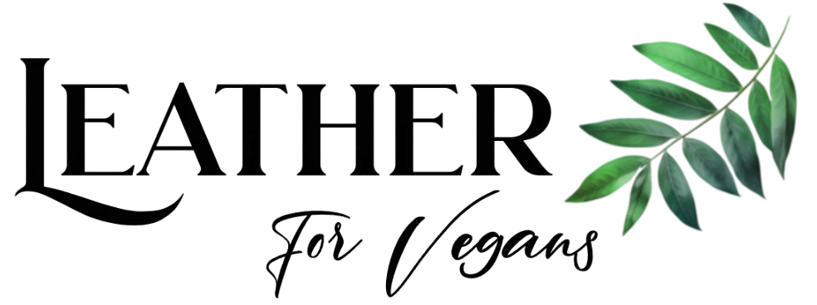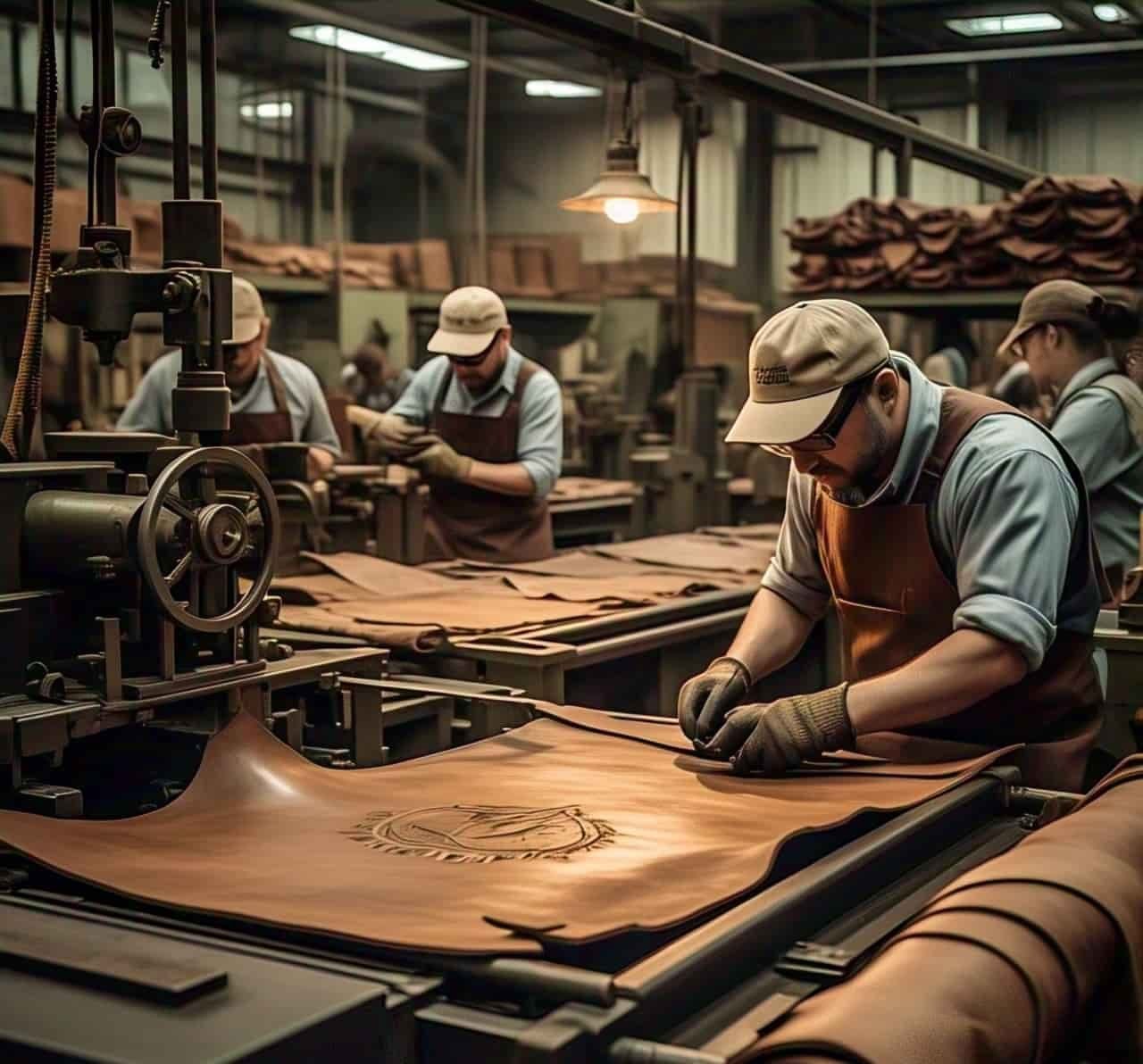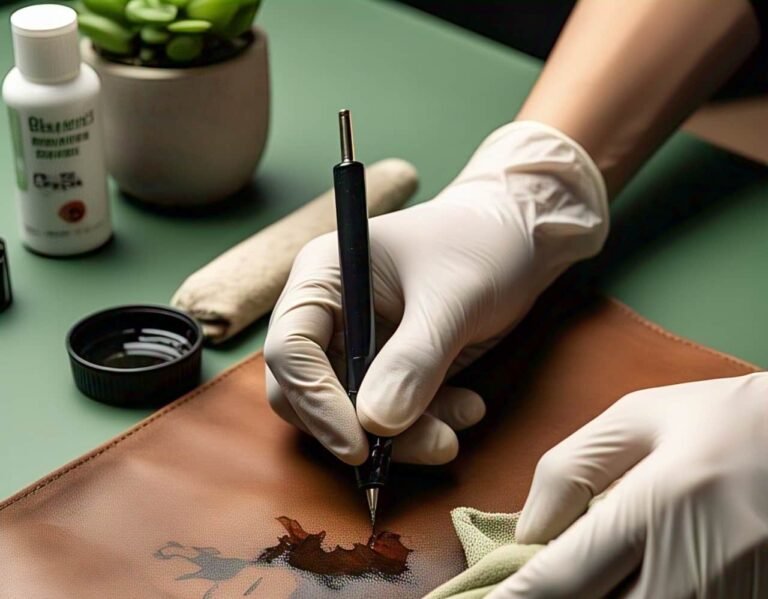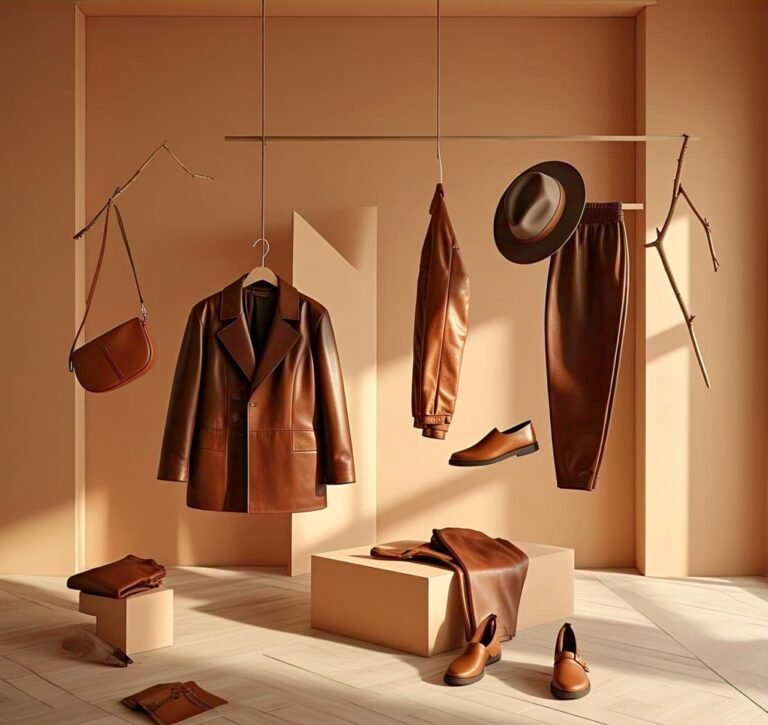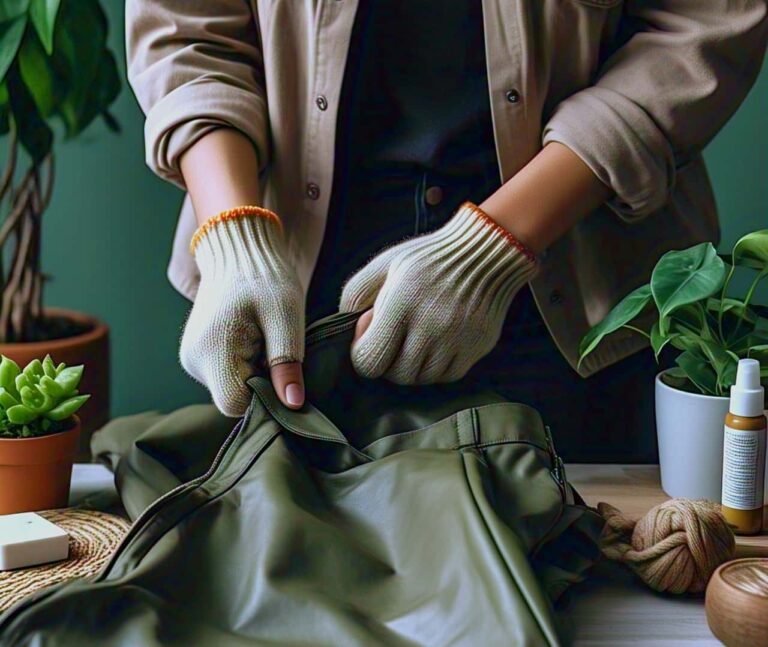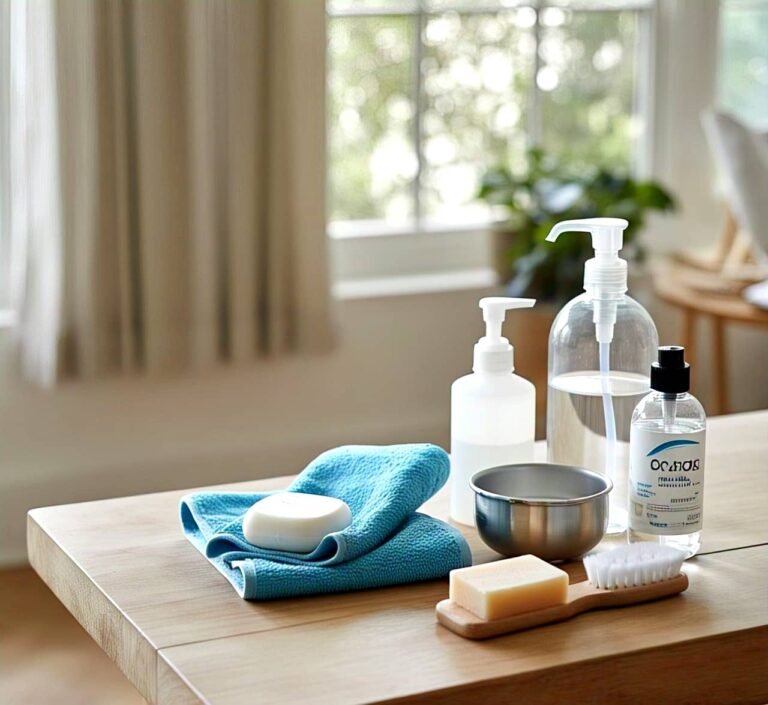How Faux Leather Is Made? From Raw Materials To Final Product
Faux leather is made in different ways, and each type has its own unique way. It is not just limited to clothes, but has spread everywhere including furniture, car interiors, bags, and shoes. The biggest advantages are waterproof, easy maintenance, and full support for vegans!
Earlier people thought only real leather was good, but now people have started understanding the fundamentals of vegan lifestyle, sustainability, and budget.
Faux leather is not just a synthetic material, but its raw material collection, manufacturing, and quality check is done in a different way. In this guide, we will give a step-by-step breakdown on how faux leather is made, which raw materials are used, what needs to be kept in mind during its manufacturing.
How different types of Faux Leather is Made

1. Polyurethane (PU) Leather
PU leather is used the most because it feels like real leather and is also soft, lightweight, and breathable. This process goes something like this:
- Prepare the Base Material: First a fabric base is taken, which can be of cotton or polyester. This base material should be very strong so that the upper coating can stick well.
- Apply Polyurethane Coating: A special polyurethane layer is applied over this fabric which makes it leather-like. This layer is made of synthetic polymer which is strong and flexible.
- Add Texture: Now the process of embossing comes here. This PU layer is pressed with a hot roller to give it a texture like real leather. The wrinkles and grains that you see in real leather are created here.
- Finishing Touch: Finally a protective coating is applied to enhance the colour, shine, and durability. This coating makes it waterproof, scratch-resistant, and gives a great glossy look.
PU leather is very good for furniture, jackets, and shoes. It is easy to clean and feels a little soft when you touch it.
2. Polyvinyl Chloride (PVC) Leather
PVC leather is more durable and waterproof, but a little less breathable than PU. Its method of making is also a little different:
- Prepare the fabric base: First of all, a strong fabric base is taken, which can be polyester or cotton.
- Apply PVC paste: A thick polyvinyl chloride (PVC) paste is applied on this base. It is a synthetic plastic which is super durable.
- Add Plasticizer: This is a chemical that makes PVC flexible. If this is not added, the leather will become extremely stiff.
- Embossing and Coloring: A texture similar to that of original leather is applied over the PVC layer and it is given different colors and patterns.
- Protective Coating: Finally a lamination or polish coating is applied which makes it waterproof and scratch-resistant.
PVC leather is mostly used in car seats, bags, and furniture because it is water-resistant and long-lasting.
3. Plant-Based Faux Leather
Now, let’s talk about eco-friendly and sustainable leather. Plant-based leather is made using only natural source materials. It uses a little synthetic chemicals and also make less impact on the environment. It is made from different plants like pineapple, mushroom, apple, and cactus. Each one has a different process, but understand the overall basic steps:
Collect Plant Material
First of all, the raw material of the plant from which the leather is to be made is collected:
For pineapple leather (Piñatex), pineapple leaves are used which normally go as waste. In mushroom leather (Mylo), the mycelium (network of roots) of fungus is used.
Apple leather uses waste from the apple juice industry, such as peels and pulp. Cactus leather uses dried cactus leaves and fibers.
Fiber Extraction
Plant waste is processed to extract fibers. These fibers are strong and form a soft and flexible layer just like real leather.
In mushroom and pineapple leather, these fibers naturally form a sponge-like structure that forms the base of the leather.
Natural Binding Process
These fibers are bound together with resin, plant-based glue, and natural polymers. This step gives an organic touch to artificial leather instead of synthetic polymers.
Sometimes a little coating of PU is applied for extra flexibility and durability, but in very small quantities.
Texture & Coloring
Plant-based leather already has a natural texture, but heat pressing and embossing is used to give it a feel similar to real leather.
It is then colored with natural or water-based dyes to give a vibrant and durable finish.
Finishing & Drying
Lastly, a protective coating is applied which makes it waterproof and scratch-resistant.
This coating is mostly wax or bio-resin, which is better than synthetic coatings.
Then the leather is dried and given a final treatment to make it soft.
End Result:
Extremely natural, stylish, and eco-friendly leather which is used in bags, shoes, jackets and furniture.
4. Silicone Leather
Silicone leather is a bit high-tech innovation. It is artificial, but makes a less impact on the environment, because it doesn’t contain BPA or There are no harmful plasticizers. The process is something like this:
Choose the Base Fabric
- A strong polyester or microfiber fabric is used as the base.
- This fabric is durable so that the silicone coating on top can be easily glued.
Silicone Preparation
- Silicone is a non-toxic and flexible polymer made from sand (silica).
- It is made into a special gel-like consistency so that it is smooth and strong.
Coating Process
- Silicone gel is applied evenly to the fabric by high-pressure spraying.
- It is applied in multiple thin layers to give a very smooth and premium finish.
Texturing and Leather-Like Feel
- Silicone is naturally soft and flexible, but heat embossing is used to give it the look of real leather.
- This process gives it a grained texture that looks like real leather.
Coloring & Protection Layer
- Silicone leather uses natural or chemical-free dyes that do not fade.
- Then it is finished with a UV-resistant and waterproof coating, making it scratch-proof and heat-proof.
End Result:
Excellent, high-performance leather that resists heat, chemicals, and scratches. Mostly used in car interiors, medical equipment, and premium furniture.
5. Composite Faux Leather
This is a hybrid leather which is a mix of different materials, so that you get the best quality of each and the price is not too high. Its process is a bit fun and technical. The process is a little detailed, understand it carefully:
Prepare the Base Material
- Its base is made of polyester fabric or reprocessed leather fibers.
- Sometimes small pieces of recycled leather are also used which help in reducing waste.
Apply Synthetic Coating
- A layer of PU or PVC is given on top of the base to add durability and flexibility.
- This layer is applied using a special hot-melt coating process which is strong and spreads evenly.
Add Layering and Strength
- Now another fiber reinforcement is added to it, which can be PU, microfiber or another synthetic layer.
- This multi-layered process makes it more durable and stronger than normal faux or vegan leather.
Texturing & Color Customization
- An embossing roller is used which gives it the look and feel of real leather.
- After this, colors and patterns are given which are customized according to the consumer’s demand.
Protective Finishing
- Lastly a lamination or clear coat is applied which makes it waterproof, UV-resistant, and stain-proof.
- This coating also gives it a soft touch and premium look.
End Result:
A great budget-friendly and durable leather which is used in bags, wallets, furniture, and car seats. It can be used everywhere because it is affordable and versatile.
Source of Raw Materials of Faux Leather – How is it collected?
The important thing about faux or vegan leather is that its base material and coating material are different. These are made from synthetic polymers (PU, PVC), fabric layers, and sometimes plant-based fibers.
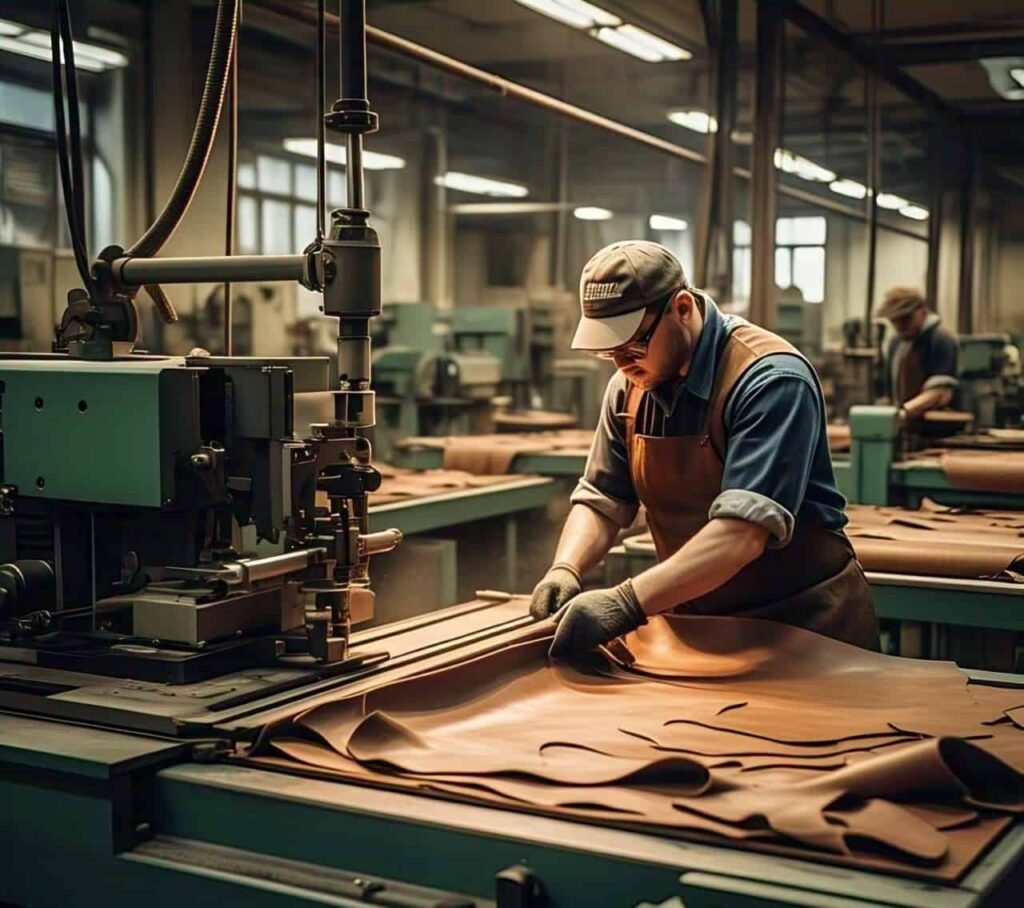
Selection of Base Material
The base material of faux leather should be strong, which maintains a balance of flexibility, durability, and softness. It is made up of 3 major materials:
- Polyester Fabric: This is a very common base material which is lightweight and strong. It easily absorbs synthetic coatings and is very durable.
- Cotton Fabric: It is soft and breathable, mostly used in premium faux leather.
- Microfiber Base: It is made up of high-quality synthetic fibers which give a feel like real leather.
Collection of Coating Material
The upper layer of faux leather is prepared from a synthetic coating, which gives it the look and texture of real leather. It is made from different materials:
- Polyurethane (PU): A soft and flexible plastic coating that looks and feels like real leather. It is breathable and used in premium products.
- Polyvinyl Chloride (PVC): It is waterproof and strong, mostly used in car interiors and heavy-duty furniture.
- Silicone: It is slightly premium and eco-friendly, and is also heat and chemical resistant.
Raw Materials of Plant-Based Faux Leather
If we talk about eco-friendly and biodegradable leather, then it is obtained from different natural sources:
- Pineapple Leaves: Pineapple leaves are used for Piñatex leather, which normally go as waste.
- Mushroom Mycelium: Leather-like material is made by growing the root network of mushrooms.
- Apple Peels & Pulp: Leather-like fabric is made by using waste from the apple juice industry.
- Cactus Plants: It is made from the leaves of cactus which are naturally durable.
Collection of Chemical Agents
Special chemicals and resins are used to make leather flexible and keep it waterproof and strong:
- Plasticizers: These chemicals make leather flexible.
- Color Pigments: Natural or synthetic dyes are used to get leather in different colors.
- UV & Scratch Protection Coating: This is a thin transparent layer that makes leather durable.
Measurements And Safety Precautions
Making faux leather is a technical and detailed process. If the correct measurements and safety standards are not followed, the quality of the leather can be lost. Let’s see step-by-step what needs to be kept in mind during manufacturing.
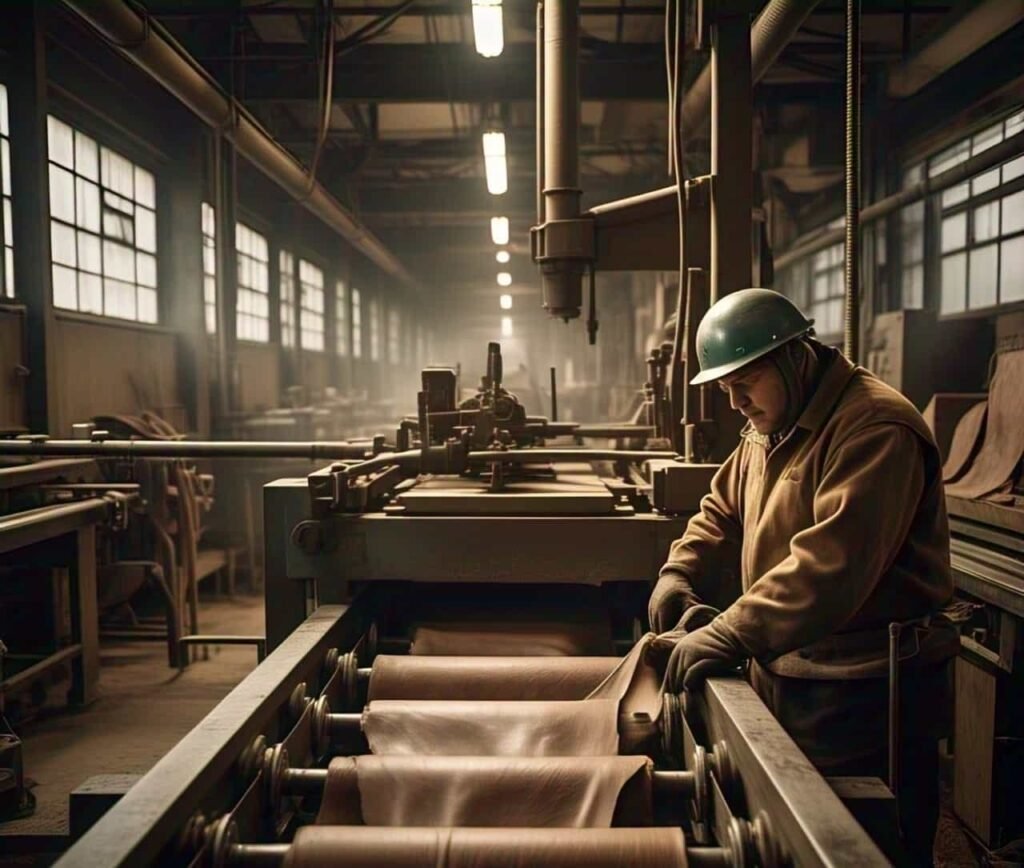
Proper Inspection of Raw Material
First of all, the quality of fabric base and synthetic polymers is checked. It is important to see that:
- The fabric is tear-resistant and strong.
- The PU or PVC coating is of proper mix and non-toxic.
- If it is plant-based leather, then the fibers should be well treated.
Thickness and Evenness of Coating
The thickness of PU or PVC coating should be equal, otherwise the leather will look too thick or too thin.
The thickness should be minimum 0.5 mm and maximum 2 mm, depending on usage.
Heat & Pressure Control
The heat and pressure should be absolutely perfect during embossing and texturing, otherwise the leather surface may become uneven or damaged.
Normal PU leather requires 120-150°C and silicone leather requires up to 200°C.
Following Safety Standards
The chemical fumes emitted during manufacturing have to be properly filtered.
Workers have to wear protective gear, as some fumes of PVC and PU can be harmful.
Eco-friendly products use low-VOC chemicals, which are better for health and the environment.
Pros and Cons of Faux Leather
Everything has pros and cons and the biggest plus point of faux leather is that it is animal-friendly and budget-friendly, but there are some downsides too which are important to understand. Let’s see a complete breakdown.
Pros
Cruelty-Free & Vegan: The biggest plus point is that it is made without the skin of any animal. It is an absolute animal-friendly option.
- Budget-Friendly: It is much cheaper than real leather, and the quality is also decent.
- Low Maintenance: It does not require much polishing or oiling, it can be easily cleaned.
- Waterproof & Stain Resistant: PU and PVC leather is safe from water and stains.
- Lightweight & Flexible: It is soft and lightweight, so it is popular in bags and jackets.
Cons
- Durability is low: It is not as long-lasting as real leather, cracks and peeling can occur in 5-7 years.
- Breathability is low: PU and PVC leather is not so breathable, so it can become hot and chipped.
- Not Eco-Friendly (PVC Leather): PVC leather contains plastic-based chemicals which are not biodegradable.
Application of Faux Leather – Where Is It Used?
The use of faux leather is not limited to fashion and furniture. It has entered everywhere – cars, shoes, mobile covers, gaming chairs, it is making a splash everywhere. Let’s see which major industries are using it.
Entry In The Fashion Industry
- Jackets & Coats: Stylish jackets and coats are made without using real leather and without harming any animal.
- Bags & Wallets: Designer brands have also started using PU and plant-based leather because it is durable and cost-effective.
- Shoes & Boots: Normal leather boots are available in the market, but faux leather shoes look extremely classy in the budget.
Demand is High In Furniture Industry
- Sofas & Chairs: Faux leather sofas and recliners give a very premium look without spending money on real leather.
- Car Seats & Interiors: Car companies are also using PVC and PU leather to get waterproof and durable interiors.
- Gaming Chairs: Nowadays, there is a craze for gaming setup, in that too faux leather chairs are the best combo of comfort and swag.
Other Special Applications
- Mobile Covers & Accessories: Faux leather phone cases give a very royal look.
- Car Dashboard Covers: Due to being heat and scratch-proof, it is also being used in car dashboards and gear covers.
- Medical & Hospitality Industry: Hospitals and clinics require sanitized and waterproof furniture, so faux leather is the perfect choice.
Future Growth of Faux Leather
Today the demand for vegan and eco-friendly products has increased so much that the market for faux leather will grow bigger in the future. Big brands in the industry have also started using plant-based and high-tech synthetic leather. Let’s see how its future is going to be amazing.
Boom of Eco-Friendly and Plant-Based Leather
Now people are moving away from plastic-based leather and focusing on leather made from cactus, pineapple and mushroom.
New innovative options like Piñatex, Mylo, and Apple leather have started coming up.
Technology and Quality Upgrade
Earlier faux leather used to feel a bit stiff and plastic-y, but now new materials are being used which give the feel of real leather.
New materials like silicone leather and bio-based PU leather have started giving a premium look and durability.
Frequently Asked Questions
1. Is faux leather as strong as real leather?
No, if compared to real leather then faux leather is a bit less durable. Real leather can last for 10-20 years, but faux leather remains in best condition for 5-7 years. Yes, silicone and high-quality PU leather options are more durable.
2. Will faux leather wear out or peel quickly?
If you buy cheap and low-quality PU leather, then yes, it can crack or peel in 2-3 years. But if you use good quality plant-based or silicone leather, the durability is great.
3. Is faux leather waterproof?
Yes, PVC and PU leather are absolutely waterproof. That’s why it is used in car interiors and sofas. But yes, if you buy cheap stuff then it can get damaged quickly by water.
4. Is faux leather environment-friendly?
PVC leather options are not very good for the environment as they are plastic-based and non-biodegradable. Plant-based and silicone leather are a better option as they are eco-friendly and sustainable.
5. Is the maintenance of faux leather easy?
Yes, there is no need for polishing and conditioning like real leather. Just clean it with a wet cloth and the job is done.
6. Is faux leather more expensive?
No, it is cheaper and budget-friendly than real leather. But if you buy high-quality faux leather or plant-based leather, it comes at premium pricing.
Conclusion
Faux leather is not just an alternative, but is emerging as a new trend in the fashion and luxury market. The manufacturing process is also becoming advanced and eco-friendly, in which new materials like Piñatex, Mylo and Silicone leather are also entering.
If you want a budget-friendly and stylish look, then faux leather item is the right choice.
